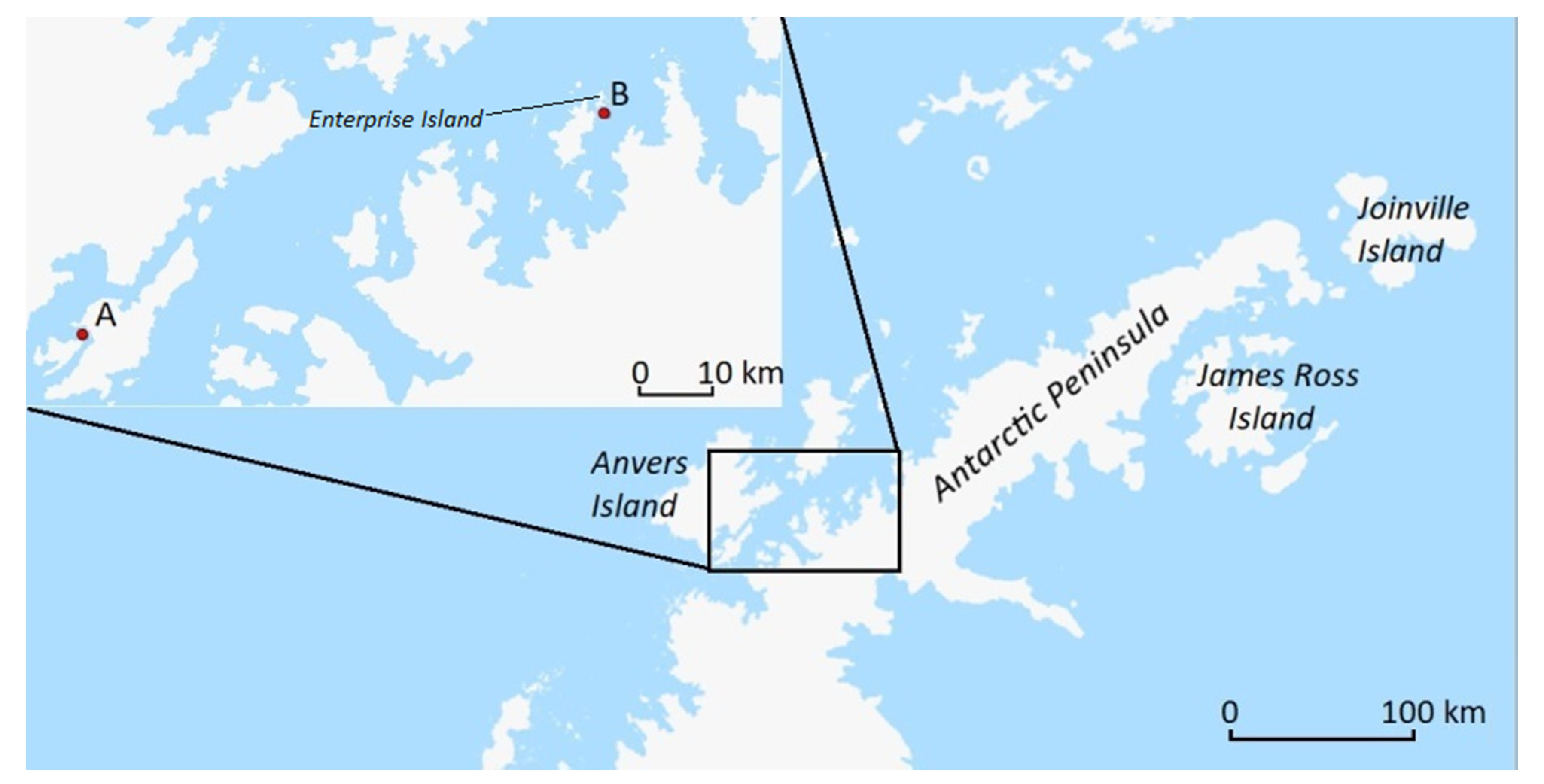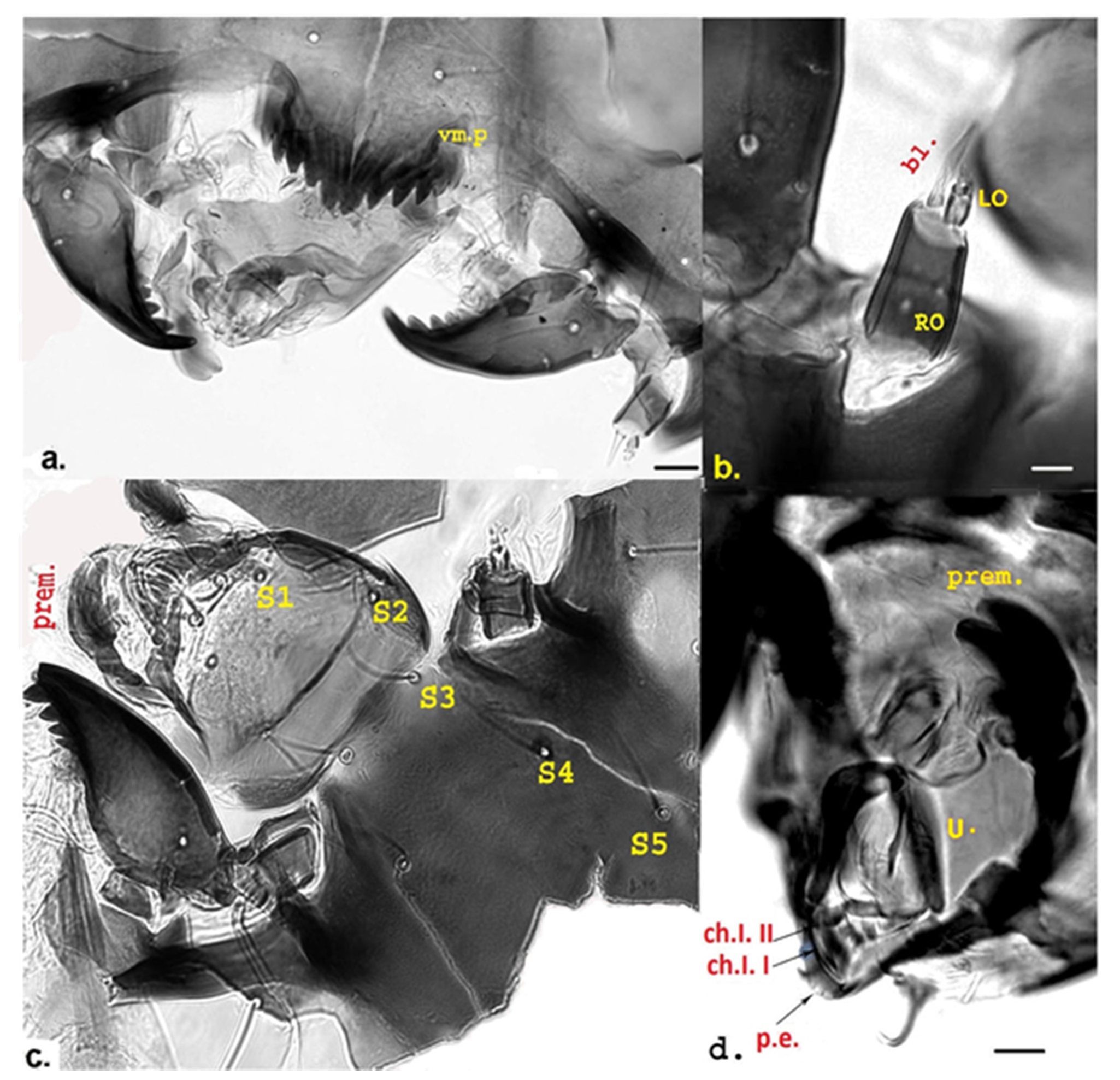External Morphology of Larvae of Belgica antarctica Jacobs, 1900 (Diptera, Chironomidae) Obtained from Two Locations in Maritime Antarctica
Abstract
:Simple Summary
Abstract
1. Introduction
2. Materials and Methods
3. Results
Morphology of Belgica antarctica Fourth-Instar Larva
4. Discussion
5. Conclusions
Author Contributions
Funding
Institutional Review Board Statement
Informed Consent Statement
Data Availability Statement
Acknowledgments
Conflicts of Interest
References
- Convey, P.; Block, W. Antarctic Diptera: Ecology, physiology and distribution. Eur. J. Entomol. 1996, 93, 1–13. [Google Scholar]
- Allegrucci, G.; Carchini, G.; Todisco, V.; Convey, P.; Sbordoni, V. A molecular phylogeny of Antarctic Chironomidae and its implications for biogeographical history. Polar Biol. 2006, 29, 320–326. [Google Scholar] [CrossRef]
- Allegrucci, G.; Carchini, G.; Convey, P.; Sbordoni, V. Evolutionary geographic relationships among orthocladine chironomid midges from maritime Antarctic and sub-Antarctic islands. Biol. J. Linn. Soc. 2012, 106, 258–274. [Google Scholar] [CrossRef] [Green Version]
- Chown, S.L.; Convey, P. Antarctic Entomology. Annu. Rev. Entomol. 2016, 61, 119–137. [Google Scholar] [CrossRef] [PubMed]
- Finch, G.; Nandyal, S.; Perretta, C.; Davies, B.; Rosendale, A.J.; Holmes, C.J.; Gantz, J.D.; Spacht, D.E.; Bailey, S.T.; Chen, X.; et al. Multi-level analysis of reproduction in an Antarctic midge identifies female and male accessory gland products that are altered by larval stress and impact progeny viability. Sci. Rep. 2020, 10, 19791. [Google Scholar] [CrossRef] [PubMed]
- Teets, N.M.; Dalrymple, E.G.; Hillis, M.H.; Gantz, J.D.; Spacht, D.E.; Lee, J.R.E.; Denlinger, D.L. Changes in energy reserves and gene expression elicited by freezing and supercooling in the Antarctic midge, Belgica antarctica. Insects 2020, 11, 18. [Google Scholar] [CrossRef] [Green Version]
- Kozeretska, I.; Serga, S.; Kovalenko, P.; Gorobchyshyn, V.; Convey, P. Belgica antarctica—A key natural model organism for extreme environments. Insect Sci. 2021. [Google Scholar] [CrossRef]
- Jacobs, J.C. Diagnoses d’insectes recueillis par l’expedition antarctique Belge (parte Chironomidae). Ann. Société Entomol. Belg. 1900, 44, 107–108. [Google Scholar]
- Rübsaamen, E.H. Chironomidae. In Résultats du Voyage du S.Y. Belgica en 1897–1898–1899: Sous le Commandement de A. de Gerlache de Gomery. Rapports Scientifiques Publiés aux Frais du Gouvernement Belge, sous la Direction de la Commission de la Belgica; de Gomery, G., Ed.; Buschmann: Antwerp, Belgium, 1906; Volume R30-A50: Zoologie Insectes; pp. 75–85. (In French) [Google Scholar]
- Roubard, M.E. Diptères. In Expédition Antarctique Francaise (1903–1905); Charcot, J., Ed.; Masson: Paris, France, 1907; pp. 11–12. (In French) [Google Scholar]
- Keilin, D. Sur I’anatomie et Ie dkveloppement de Bclgica antarctica Jacobs, Chironomide antarctique a ailes rkduites. Comptes Rendus Acad. Sci. 1912, 154, 723–725. (In French) [Google Scholar]
- Keilin, D. Diptères. Belgica antarctica Jacobs. In Deuxième Expédition Antarctique Francaise (1908–1910). Sciences Naturalles: Documents Scientifiques; Charcot, J., Ed.; Masson: Paris, France, 1913; pp. 217–231. (In French) [Google Scholar]
- Usher, M.; Edwards, M. A dipteran fauna south of the Antarctic Circle: Belgica antarctica (Chironomidae) with a description of its larva. Biol. J. Linn. Soc. 1984, 23, 19–31. [Google Scholar] [CrossRef]
- Wirth, W.W.; Gressitt, J.L. Diptera: Chironomidae (Midges). Antarct. Res. Ser. 1967, 10, 197–203. [Google Scholar]
- Peckham, V. Notes on the chironomid midge Belgica antarctica. Pac. Insects Monogr. 1971, 25, 145–166. [Google Scholar]
- Atchley, W.; Hilburn, L. Morphometric variability in larvae of the Antarctic fly, Belgica antarctica (Diptera: Chironomidae). Can. J. Zool. 1979, 57, 2311–2318. [Google Scholar] [CrossRef]
- Sugg, P.; Edwards, J.S.; Baust, J. Phenology and life history of Belgica antarctica, an Antarctic midge (Diptera: Chironomidae). Ecol. Entomol. 1983, 8, 105–113. [Google Scholar] [CrossRef]
- Michailova, P.; Ilkova, J.; Kovalenko, P.A.; Dzhulai, A.; Kozeretska, I.A. Long-term retainment of some chromosomal inversions in a local population of Belgica antarctica Jacobs (Diptera, Chironomidae). Czech Polar Rep. 2021, 11, 16–24. [Google Scholar] [CrossRef]
- Wülker, W.; Götz, G. Die Vervendung der Imaginalscheiben des Entwicklunszustndes von Chironomus Larven. Z. Morphol. Tiere 1968, 62, 363–388. (In German) [Google Scholar] [CrossRef]
- Pinder, L.C.V. A key of the adult males of the British Chironomidae (Diptera). Freshwater Biol. Assoc. Publ. 1978, 37, 1–169. [Google Scholar]
- Sæther, O.A. Glossary of chironomid morphology terminology (Diptera: Chironomidae). Entomol. Scand. Suppl. 1980, 14, 1–51. [Google Scholar]
- Warwick, W.F. The use of morphological deformities in chironomid larvae for biological effects monitoring. Inland Water Directorate Sci. Ser. 1990, 173, 1–34. [Google Scholar]
- Wise, R.R.; Pierstorff, C.A.; Nelson, S.L.; Bursek, R.M.; Plude, J.L.; McNello, M.; Hein, J. Morphological Deformities in Chironomus (Chironomidae: Diptera) larvae as indicators of pollution in Lake Winnebago, Wisconsin. J. Great Lakes Res. 2001, 27, 503–509. [Google Scholar] [CrossRef]
- Al-Shami, S.; Salmah, M.; Siti-Azizah, M.; Hassan, A.; Ali, A. Morphological deformities in Chironomus spp. (Diptera: Chironomidae) larvae as a tool for impact assessment of anthropogenic and environmental stresses on three rivers in the Juru River system, Penang, Malaysia. Environ. Entomol. 2010, 39, 210–222. [Google Scholar] [CrossRef] [PubMed]
- Youbi, A.; Zerguine, K.; Houilia, A.; Farfar, K.; Soumati, B.; Berrebbah, H.; Djebar, M.R.; Souiki, L. Potential use of morphological deformities in Chironomus (Diptera: Chironomidae) as a bioindicator of heavy metals pollution in North-East Algeria. Environ. Sci. Pollut. Res. 2020, 27, 8611–8620. [Google Scholar] [CrossRef]
- Salmelin, J.; Vuori, K.M.; Hämäläinen, H. Inconsistency in the analysis of morphological deformities in chironomidae (Insecta: Diptera) larvae. Environ. Toxicol. Chem. 2015, 34, 1891–1898. [Google Scholar] [CrossRef] [PubMed]
- Bhattacharyay, G.; Sadhu, A.K.; Mazumdar, A.; Chaudhuri, P.K. Antennal deformities of chironomid larvae and their use in biomonitoring of heavy metal pollutants in the river Damodar of West Bengal, India. Environ. Monit. Assess. 2005, 108, 67–84. [Google Scholar] [CrossRef] [PubMed]
- Reynolds, S.; Ferrington, L. Differential morphological responses of chironomid larvae to severe heavy metal exposure (Diptera: Chironomidae). J. Kans. Entomol. Soc. 2002, 75, 172–184. [Google Scholar]
- Parnikoza, I.; Abakumov, E.; Korsun, S.; Klymenko, I.; Netsyk, M.; Kudinova, A.; Kozeretska, I. Soils of the Argentine Islands, Antarctica: Diversity and characteristics. Polarforschung 2017, 86, 83–96. [Google Scholar] [CrossRef]
- Servia, M.; Cobro, F.; Gonzalez, M. Seasonal and interannual variation in the frequency and severity of deformities in larvae of Chironomus riparius (Meigen, 1804) and Prodiamesa olivacea (Meigen, 1818) (Diptera, Chironomidae) collected in a polluted site. Environ. Monit. Assess. 2000, 64, 617–626. [Google Scholar] [CrossRef]
- Michailova, P.; Sella, G.; Petrova, N. Chironomids (Diptera) and their salivary gland chromosomes as indicators of trace metal genotoxicology. Ital. J. Zool. (Modena) 2012, 79, 218–230. [Google Scholar] [CrossRef]





| Vm.W | M.W | H. of Mand. | W. of Mand. | D1 | D2 | L1 | L2 |
|---|---|---|---|---|---|---|---|
| 54 | 92 | 106 | 32 | 65 | 9 | 27 | 8 |
| 65 | 92 | 107 | 32 | 65 | 9 | 26 | 7 |
| 60 | 96 | 106 | 32 | 61 | 8 | 27 | 5 |
| 60 | 92 | 110 | 31 | 68 | 9 | 28 | 8 |
| 62 | 92 | 110 | 27 | 68 | 9 | 29 | 6 |
| 60.2 ± 4.0249 * | 92.8 ± 1.7888 * | 107.8 ± 2.0494 * | 30.8 ± 2.1678 * | 65.4 ± 2.8809 * | 8.8 ± 0.4472 * | 27.4 ± 1.402 * | 6.8 ± 1.3038 * |
| Vm.W n = 7 | M.W n = 7 | H. of Mand. n = 10 | W. of Mand. n = 10 | D1 n = 7 | D2 n = 9 | L1 n = 9 | L2 n = 9 |
|---|---|---|---|---|---|---|---|
| 65 | 104 | 104 | 41 | 66 | 9 | 22 | 6 |
| 60 | 100 | 109 | 46 | 65 | 12 | 21 | 6 |
| 62 | 96 | 111 | 39 | 63 | 10 | 21 | 7 |
| 62 | 101 | 99 | 44 | 57 | 8 | 21 | 8 |
| 60 | 98 | 103 | 35 | 67 | 6 | 23 | 6 |
| - | - | 107 | 39 | 67 | 7 | 21 | 6 |
| - | - | 111 | 43 | - | 7 | 19 | 6 |
| 56 | 96 | 123 | 47 | - | 6 | 23 | 5 |
| 57 | 95 | 105 | 36 | 62 | - | - | - |
| - | - | 112 | 43 | - | 9 | 20 | 6 |
| 60.2 ± 3.0938 * | 98.6 ± 3.2587 * | 108.4 ± 6.5862 * | 41.3 ± 4.0291 * | 63.9 ± 3.5790 * | 8.2 ± 1.9861 * | 21.2 ± 1.3017 * | 6.2 ± 0.8333 * |
| Larval Feature | Current Study | Wirth and Gressitt 1967 | Usher and Edwards 1984 |
|---|---|---|---|
| Length | 7–8 mm | 4.5–5 mm | 6–7 mm |
| Mandible—number of teeth | 5; 19% with 4 teeth | 5 | 5 |
| Mentum—number of lateral teeth | 5 | 5 | 5 |
| Antenna—number of segments | 4 | 5 | 5 |
| Antennal blade | Jougla Point—reached the fourth segment; un-named island near Enterprise Island—exceeded the last segment | exceeded the last segment | exceeded the last segment |
Publisher’s Note: MDPI stays neutral with regard to jurisdictional claims in published maps and institutional affiliations. |
© 2021 by the authors. Licensee MDPI, Basel, Switzerland. This article is an open access article distributed under the terms and conditions of the Creative Commons Attribution (CC BY) license (https://creativecommons.org/licenses/by/4.0/).
Share and Cite
Michailova, P.; Ilkova, J.; Kovalenko, P.A.; Gorobchyshyn, V.A.; Kozeretska, I.A.; Convey, P. External Morphology of Larvae of Belgica antarctica Jacobs, 1900 (Diptera, Chironomidae) Obtained from Two Locations in Maritime Antarctica. Insects 2021, 12, 792. https://doi.org/10.3390/insects12090792
Michailova P, Ilkova J, Kovalenko PA, Gorobchyshyn VA, Kozeretska IA, Convey P. External Morphology of Larvae of Belgica antarctica Jacobs, 1900 (Diptera, Chironomidae) Obtained from Two Locations in Maritime Antarctica. Insects. 2021; 12(9):792. https://doi.org/10.3390/insects12090792
Chicago/Turabian StyleMichailova, Paraskeva, Julia Ilkova, Pavlo A. Kovalenko, Volodymyr A. Gorobchyshyn, Iryna A. Kozeretska, and Peter Convey. 2021. "External Morphology of Larvae of Belgica antarctica Jacobs, 1900 (Diptera, Chironomidae) Obtained from Two Locations in Maritime Antarctica" Insects 12, no. 9: 792. https://doi.org/10.3390/insects12090792
APA StyleMichailova, P., Ilkova, J., Kovalenko, P. A., Gorobchyshyn, V. A., Kozeretska, I. A., & Convey, P. (2021). External Morphology of Larvae of Belgica antarctica Jacobs, 1900 (Diptera, Chironomidae) Obtained from Two Locations in Maritime Antarctica. Insects, 12(9), 792. https://doi.org/10.3390/insects12090792







